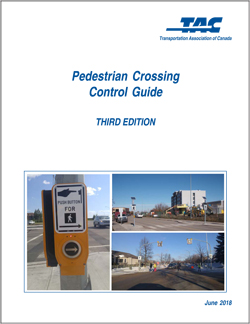The Transportation Association of Canada (TAC) has released Pedestrian Crossing Control Guide (Third Edition) in its online Bookstore. The document is priced at $129 for TAC members and $169 for non-members (order code PTM-PCCG18-E) and is available in both print and e-book formats.
 The Guide was created under the umbrella of TAC's Chief Engineers' Council and the Traffic Operations and Management Standing Committee.
The Guide was created under the umbrella of TAC's Chief Engineers' Council and the Traffic Operations and Management Standing Committee.
Luay Mustafa, Project Manager, says the main objective of this Guide is to promote uniformity across the country with respect to the approach used in the provision of pedestrian crossing control. This is done through the development of a decision support tool to assist in the decision-making process when: (1) establishing the need for controlling the traffic to enable pedestrians to cross the roadway safely and (2) identifying the type of traffic control device that would be most suitable for the location’s cross section, vehicular exposure, and pedestrian demand.
This is the third edition of the Pedestrian Crossing Control Guide, replacing the second edition which was published by TAC in 2012. This Third Edition reflects changes in pedestrians and planning, design and operations of road system, pedestrian crossing control treatment system, components and selection, as well as typical applications. The table of contents of the Guide can be referenced online.
Readers of the second edition of the guide may be interested to note the following changes made in this third edition:
- A new section about considerations for specific environments, including smaller communities and rural environments, has been added.
- A new section about pedestrian activity is included to help better understand the characteristics of pedestrian travel. The section also describes the concept of latent demand which is a measure of the potential volume of pedestrians that may use a crossing if one were provided.
- A new section is included about geometric design components (e.g., curb extensions, offset crosswalk arrangement, curb corner radius reduction) that can be used to enhance pedestrian crossing locations. These geometric design components are included as desirable or optional components for several treatment systems.
- A new treatment system, enhanced crosswalk with side-mounted signs (GM+), is included in this Guide and incorporated into the Treatment Selection Matrix. The rationale for inclusion of this new treatment, GM+, is to continue to provide a crossing treatment option for lower speed (≤60 km/h), low volume (≤ 9000 ADT) crossing environments, while still providing flexibility for the practitioner to select which enhancements may be best for the particular crossing location. Research shows that there are multiple ways to increase the conspicuity of a crossing (such as advance yield lines, curb extensions, raised pedestrian refuge, and in-street signs) in addition to overhead mounted signs (Mead, Zegeer, & Bushell, 2014; Thomas, Thirsk, & Zegeer, 2016; Zegeer et al., 2016).
- The crosswalk with overhead mounted signs treatment system (described as the GM2 treatment system in the Pedestrian Crossing Control Guide, Second Edition) has been removed from this Guide as a standalone recommended treatment system. Overhead mounted signs are now included as one of the desirable components of the GM+ system.
- Rectangular rapid flashing beacons (RRFB) are included as a new treatment system and incorporated into the Treatment Selection Matrix.
- The Preliminary Assessment methodology has been revised to include latent crossing demand and an updated discussion of pedestrian desire lines and system connectivity.
- The Treatment Selection Matrix has been updated to reflect the inclusion of the new GM+ and RRFB treatment systems.
- The Advanced Yield Here to Pedestrians Sign was introduced to accompany the corresponding pavement marking.
The Pedestrian Crossing Control Guide (Third Edition) was developed with funding provided by Alberta Transportation; British Columbia Transportation and Infrastructure; Nova Scotia Transportation and Infrastructure Renewal; Prince Edward Island Transportation, Infrastructure and Energy; le ministère des Transports, de la Mobilité durable et de l’Électrification des transports du Québec; CITE; Halifax Regional Municipality; and the cities of Burlington, Edmonton, Kelowna, Ottawa, London, Montreal and Saskatoon.
 The Guide was created under the umbrella of TAC's Chief Engineers' Council and the Traffic Operations and Management Standing Committee.
The Guide was created under the umbrella of TAC's Chief Engineers' Council and the Traffic Operations and Management Standing Committee.